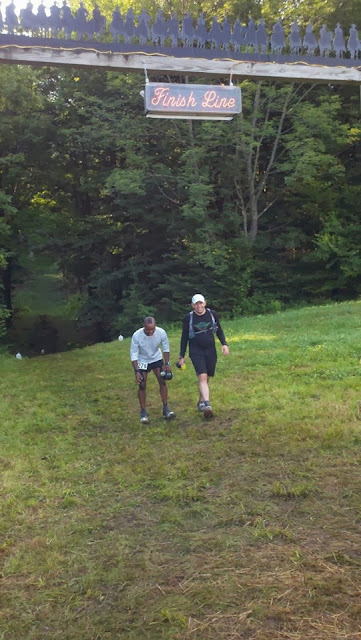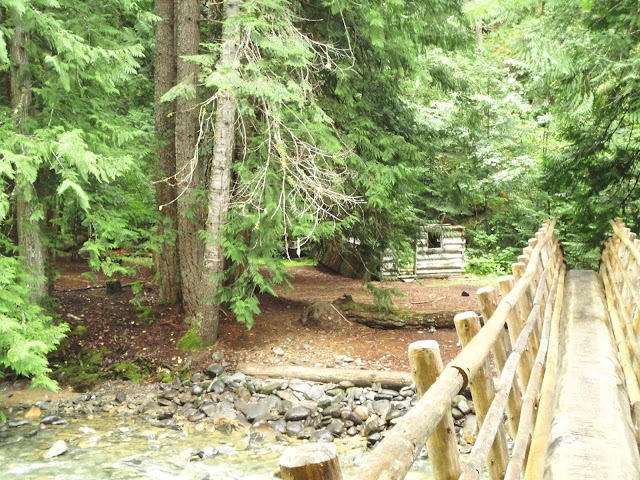#2 in the Second Amendment Soliloquy Series
(wherein I shoot my mouth off)
 by Ras
by RasThe Ultra Race Of Champions, by its very name, purports to crown ultrarunning royalty. Race Directors J. Russell Gill III & Francesca Conte envision UROC as "the annual world championship" of the sport. But exactly what sport? In issue #411 of Running Times Magazine Gill is quoted as saying, "...Ultradistance running has finally matured to a point where it needed its annual Super Bowl." This is where Mr. Gill and I take diverging paths, and a good percentage of his is paved.
I've never thought of my sport as "ultradistance running". I think of it as "ultrarunning" or "trail running" or "endurance running". And even if the term doesn't contain the word "trail" it should be assumed to be parenthetically inserted, ie "ultra(trail)running" or "endurance (trail) running". It may seem that I'm merely parsing syntax, but since we are advanced hominids using complex language, it's reasonable to assume the word choice is meant to convey a specific meaning.
I think Gill's use of "ultradistance running" convey's the amalgam of road and trail running that the UROC organizers feel sums up the sport, as has consistently been reflected in the UROC courses. They see the blend of road and trail as leveling the playing field for runners who come from either discipline. I see it as a bastardization of both. In my mind, the only reason to run on pavement is to connect sections of trail or dirt road that lack an intersection. When asked about the UROC course in the lead up to this year's race, Anton Krupicka said, "If the course isn't fair - sufficiently hilly and technical enough to appreciably differentiate it from a road race - it is going to alienate the highest-level mountain athletes." One could handily make the case that this is exactly what's happening.
In the end what it comes down to is different ways to play the game. But it's exactly those differences that interpret the sport being played. I'm a martial artist and both a participant in and fan of combat sports, and can see this point well illustrated in the fighting arts. In boxing, only striking with the closed fist is allowed. Clinches are immediately broken up by the referee, and tripping is a foul. Muay Thai (Thai Boxing) allows strikes with the fists, elbows, knees, and feet (or shins), clinching is a key component, and tripping or throwing your opponent to the mat wins points. Submission Grappling is completely based on clinching, tripping, throwing, choking and joints locks. No striking is allowed. Mixed Martial Arts allows and awards points for all of the techniques listed above.
My point being that the rules (including venue: ring, cage, trail, road) don't describe the sport, they define it. In that sense the Ultra Race Of Champions may accomplish exactly what it sets out to: crowning the King and Queen of mixed road and trail ultradistance running. To my mind that is a small fringe segment, and as a participant, that is not the sort of play that interests me. As a spectator, though, I was very excited about the elite field that the 2013 UROC had drawn.
Kilian Jornet. Rob Krar. Dakota Jones. Sage Canaday. Are you kidding me? I would tune in to watch that field on Hollywood Squares, let alone squaring off in a 100k race. Going into it I knew that the amount of asphalt would be a bane to Jornet and a boon to Jones and Canaday. I didn't know how it would play out for Rob Krar, but at mile 40 Dakota, who was trailing Krar by 4 minutes, said, "Rob Krar is really fast on the roads!" So that question has apparently been put to rest.
Rob Krar registered on my radar at about the same time I registered on his, seeing as we set our Fastest Known Times in the Grand Canyon mere days apart. When I messaged him my congratulations on his blazing fast Rim to Rim to Rim time that took down Dakota Jones' long-standing record, in addition to already holding the FKT for a single crossing, which he had set the previous year, he responded with a Friend request and the message, "Thanks Ras, equally impressive feat yourself! Love your determination to remain self supported during your effort. Stunning what your body and mind are capable of." Very cool. Very real. This wasn't just some nipple-band-aided rhinestone cowboy. Little did I know he was about to steal the Western States 100 away from an incredibly competitive elite field in his 100 mile debut.
Even though Krar came in second at Western States, he essentially stole the race from winner Timothy Olsen. When the dust had settled, Olsen received his due for his title defense at Western, but the buzz was all about Rob Krar. And rightly so. Krar didn't get caught up in the excitement and burn himself out trying to run down the elites at the start. Like an old hand at 100 miles, he settled into his pace and ran his own race, even stepping off the trail early on to let faster runners by, runners such as Ian Sharman, whom he would pass again later in the race. As the miles wore on, Krar gradually accelerated. He was extending his lead over Mike Morton and gaining ground on Tim Olsen when the finish line cut short his hunt. But one could make a convincing argument that had it been a 105 mile race, Krar would have topped the podium. It was an utterly awe-inspiring 100 mile debut. And it sparked the sort of excitement that reminded me of Anton Krupicka's appearance on the national radar.
At UROC Rob went out fast and never slowed. He led the race for roughly 50 miles. Jones then pulled into the lead for a few miles only to have Krar snatch it back and run away for the win with a three minute margin. In a turn of phrase I wish I could claim as my own, Bryon Powell referred to it as "Krarnage". Post UROC, Krar once again demonstrated both his humility, and penchant for making use of social media, tweeting to Dakota Jones, "@thatdakotajones Thanks for the most challenging and exciting race of my life. You are a BEAST. Hope our paths cross again soon!"
At mile 40 of UROC Kilian Jornet said to Bryon Powell, "That's the most I've ever run on pavement. So boring." And in some ways it seems that Jornet is not just bored with pavement, but bored with racing. I can't help but wonder if his lackluster and non-podium performance was a silent protest of sorts against the 'safety' of organized, supported races. Jornet's recent book, "Run Or Die," part autobiography and part race/FKT memoir, is rife with disillusionment with organized racing. And although Kilian asserts in his book, "...I think I run simply because I like doing it; I enjoy it every minute and don't wonder why," his performance at UROC did not reflect that.
In light of his recent speed mountaineering ascents, it seems Kilian is seeking out those moments when one takes one's life in one's hands, when a perfect performance is all that separates life and death. It calls to mind the early days of rock climbing, before bolted routes, hex nuts, and spring loaded cams, when "leader mustn't fall" expressed both the risk and the purity of the sport. And Kilian doesn't seem to be able to find that on the pavement. But his 4th place finish was more than enough to earn him the Ultra Skyrunning title for 2013. After the race Jornet tweeted, "Muy contento del titulo Ultra skyrunning y la 4a posición en la uroc, mi primera carrera de 100km trail-asfalto ;)" roughly, "Very content with the Ultra Skyrunning title and 4th place at UROC, my first 100k trail-road run." And of course, semi-colon close-parenthesis, in any language, is a winking smiley face. Yes indeed, Dr. Cooper, I believe that is sarcasm. Maybe not so silent a protest after all.
I would have liked to see Kilian give it his all. And I would LOVE to see him face off against Rob Krar on a technical mountain course, especially since Krar seems to have the chops for it. Perhaps next season we'll see Rob Krar make his presence felt on the European circuit and face off once again with the likes of Jones and Jornet on a more technical course. Transvulcania would be the perfect venue for a showdown between those three. UTMB also comes to mind. Or maybe an FKT-off in the Grand Canyon. With this trio, the venue needn't be limited to an organized, supported race.
Please understand that I mean no disrespect to or criticism of any of the race directors or runners I mentioned. I have the utmost respect for everyone involved in the Ultra Race Of Champions, both organizers and competitors. I am not saying that anyone is "doing it wrong". I support and am in favor of all forms of running, except maybe joggling. I'm not a big fan of themes or gimmicks or costumes, but I'm 100% in favor of covering miles by foot. So if someone wants to do it on asphalt, or on a rubberized track, or with an inflatable duck around their waist, far be it from me to judge. But don't expect me to play if I don't like the sport defined by the rules.





















